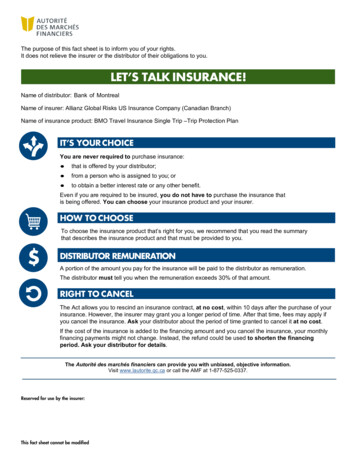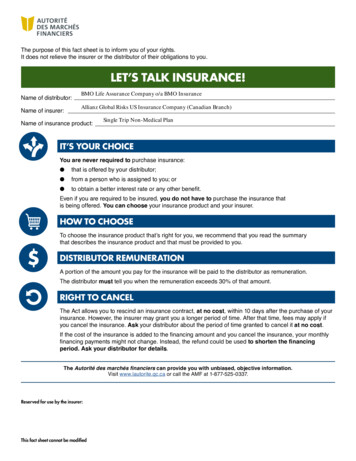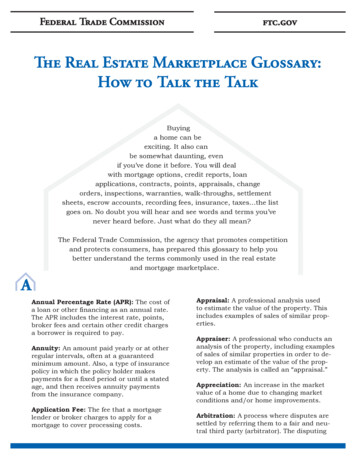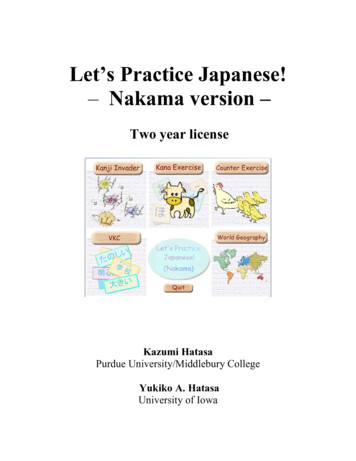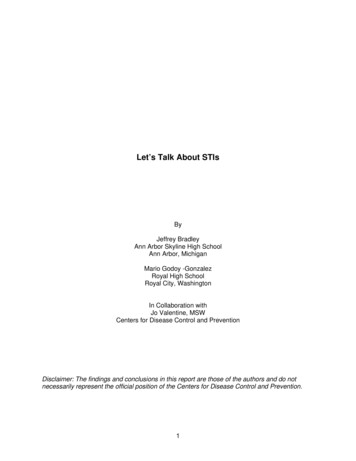
Transcription
Let’s Talk About STIsByJeffrey BradleyAnn Arbor Skyline High SchoolAnn Arbor, MichiganMario Godoy -GonzalezRoyal High SchoolRoyal City, WashingtonIn Collaboration withJo Valentine, MSWCenters for Disease Control and PreventionDisclaimer: The findings and conclusions in this report are those of the authors and do notnecessarily represent the official position of the Centers for Disease Control and Prevention.1
Let’s Talk about STIsJeffrey BradleyAnn Arbor Skyline High SchoolAnn Arbor, MichiganMario Godoy-GonzalezRoyal High SchoolRoyal City, WashingtonSummaryThis lesson is designed for a high school biology or health class to learn about sexuallytransmitted infections (STIs), understand and evaluate the risks of STIs among teenagers, anddiscuss the leading strategies to prevent STIs. The culminating activity for this lesson is thecreation of informative posters or brochures aimed at the prevention and treatment of STIs inthe local community.Included in this lesson are reading, writing, statistics, and artistic activities that lead to a widevariety of collaboration and team teaching.Learning Outcomes Students will use a Know, Want, How, Learn (KWHL) chart to activate their priorknowledge and build background about STIs. The KWHL chart is a type of graphicorganizer that helps students organize what they know and what they want to learnabout a topic before and after the research is done. Students will use graphic organizers to summarize and share information presented inthe Overview Fact Sheet on STIs from the American Social Health Association (ASHA). Students will research five (5) reliable websites to find facts and information about STIs. Students will create posters or brochures to disseminate information, prevention, andtreatment facts associated with STIs.Materials1. Sticky-easel pad sheet (30”x25”) 1 each needed per each group of 4 students forthe KWHL Activity.2. Overview Fact Sheet on STIs from ASHA3. Computers with Internet access (1 for each group of 4 students.)4. Poster boards (1 for each group interested in making informative posters.)5. Printer (1 for each groups interested in brochure making.)6. Post-It * notes to use during the silent conversation on Step 2.* Use of trade names and commercial sources is for the identification only and does not imply endorsementby the Office of Workforce and Career Development, CDC, nor the U.S. Department of Health and HumanServices.Total Duration5 hours, 50 minutes2
ProceduresTeacher PreparationThe teacher should select three to five of the STI-related websites listed below prior to theactivity. These will be the only websites students will use to gather information throughout thislesson. The teacher will review the contents of each of the chosen websites to grasp an idea ofthe facts and information they offer.The teacher should also read the ASHA Overview Fact Sheet on STIs prior the beginning of thelesson. Make two copies of the ASHA Overview Fact Sheet on STIs per group (needed for Step2). The teacher will need to reserve the use of computers and printer for Step 3.Web ResourcesTitle: The American Social Health AssociationURL: http://www.ashastd.org/learn/learn overview.cfmDescription: “Since 1914, the American Social Health Association (ASHA) has been dedicatedto improving the health of individuals, families, and communities, with a focus on preventingsexually transmitted diseases and infections (STDs/STIs) and their harmful consequences.”Title: The American Social Health Association’s website for teenagers.URL: http://www.iwannaknow.org/Description: Iwannaknow.org answers questions about teen sexual health and sexuallytransmitted diseases.”Title: Nemours Foundation’s KidsHealth and TeenHealth websiteURL: http://kidshealth.org/teen/sexual health/stds/std.htmlDescription: “TeensHealth was created for teens looking for honest, accurate information andadvice about health, relationships, and growing up. We offer a safe, private place that'saccessible 24 hours a day to get the doctor-approved [information needed] to understand thechanges [teens] may be going through — and to make educated decisions . . .”Title: The CDC National Prevention Information NetworkURL: ion: “The CDC National Prevention Information Network (NPIN) is the U.S. reference,referral, and distribution service for information on HIV/AIDS, sexually transmitted diseases(STDs), and tuberculosis (TB). NPIN produces, collects, catalogs, processes, stocks, anddisseminates materials and information on HIV/AIDS, STDs, and TB to organizations andpeople working in those disease fields in international, national, state, and local settings.”Title: The CDC’s Healthy Youth Website for Health Topics: Sexual Risks BehaviorURL: dex.htm#1Description: The CDC’s Division of Adolescent and School Health (DASH) provide the latestdata and statistics on sexual risks behavior among teenagers. The website reviews, modifies,and updates facts and data periodically.IntroductionDuration: 50 minutesThe teacher will explain to students that STIs are also known as Sexually Transmitted Diseasesor STDs. The teacher will have students create groups of four. The lesson will be introduced byusing a KWHL (Know, Want, How, Learn) chart. In order to activate students’ prior knowledge3
and build background, the teacher should give each group a sticky easel pad sheet. Divide thesheet into four sections as follows:1. “K” stands for what students already know. (It includes what students think they knowand even any misconceptions) about the topic.2. “W” stands for what students want to learn about the topic.3. “H” stands for how will students find information about the topic.4. “L” stands for what students learn from the lesson.Each group receives a chart sheet and starts a 3 to 5-minute brainstorming session to completethe “K” chart’s section. Allow students to write down all information they may think they knowabout the topic. After the 5-minute period, ask for one volunteer per group to share what his orher group wrote. Next, repeat the procedure for “W” section. Lastly, have students write downwhat they would like to know about the topic.Note: Every group should decide on three things they would like to learn. Then, groups willcomplete section “H” with resources. The resources are what the students use (or will be using)to find information and learn the facts they want to know about the topic. Emphasize theimportance of searching for reliable and current in formation in non-commercial websites andresources (particularly those URLs ending in .gov, .edu, and .org). The students must chooseresources form the teacher-selected websites noted in the Teacher Preparation section of thelesson. The charts should be on display in the classroom.Supplemental DocumentTitle: K-W-H-L ChartDescription: This chart will help students gather information, solve problems, and think throughresearch topics.Step 2:Duration: 50 MinutesAfter students have completed the first three sections of the chart, they will read the ASHAOverview Fact Sheet on STDs to focus on basic information and facts about STIs, as well asprevention efforts, treatments, and policies.Students will use a graphic organizer (concept map or idea web) to summarize the maininformation and facts presented in the fact sheet. At the center or top of the graphic organizer,have them write “STIs” and a brief definition. Students should use every subtitle as a main ideaor main concept and add at least five facts or pieces of information to share with the class. Postthe graphic organizers around the classroom for all to read.Finally, using the silent conversation technique — that is — an exchange of comments andideas written on paper. Allow the students to read all graphic organizers and write comments foreach one (compliments, opinions, etc.).Web ResourceTitle: Overview Fact Sheet on STIs from the American Social Health AssociationURL: http://www.ashastd.org/pdfs/STDOverview factsheet.pdfDescription: A 2-page document that offers an overview on STIs: basic facts, efforts to stop thespread of STIs; costs and consequences; prevention and treatment efforts; public health andpolicy issues; and facts about STIs among women, youth, and people of color.4
Step 3Duration: 2 hours, 30 minutesUsing the list of websites provided by the teacher, students should choose one (1) specific STItopic to research in depth (specific diseases with symptoms, main risks, prevention efforts, STIsamong men compared to women, STIs among people of color, STIs among teens, etc.)Students will gather information related to their topic and prepare a first draft of a poster orbrochure using either the Poster Evaluation Rubric or Brochure Evaluation Rubric forassessment. Have students turn in the first draft — allowing for an assessment for content,accuracy of data, resources used, spelling, and proofreading. Students cannot start working ontheir poster or brochure without getting the teacher’s comments and clearance.Supplemental DocumentsTitle: Poster Evaluation RubricDescription: Rubric to be used in the assessment of students’ posters.Title: Brochure Evaluation RubricDescription: Rubric to be used in the assessment of students’ brochures.ConclusionDuration: 2 hours, 30 minutesThe groups are now ready to complete the “L” section of the KWHL chart. The “L” sectionshould include what students learned during the lesson. Give emphasis to the clarification offalse information or misconceptions that students could have included on the “K” section.A class show-and-tell poster and brochure session will conclude the lesson. Each group willtake turns to have a 10-minute oral presentation in front of the class. Each member of the groupwill be asked one question by the teacher based on the information provided on the group’sposter or brochure.Rubric for presentation evaluation is included as supplemental material at the end of the lessonplan.Supplemental DocumentTitle: Oral Presentation RubricDescription: Rubric to be used in the assessment of students’ show and tell oral presentations.AssessmentTeacher will use either the Poster Evaluation Rubric or the Brochure Evaluation Rubric (Step 3)to assess each group’s knowledge. Evaluate individual students using the Presentation Rubricdescribed in the conclusion.ModificationsExtensionsOne extension idea would be to challenge students to present their poster or brochure in front ofanother biology or health class.5
Students could also make copies of their brochures to distribute among their peers at school.(The teacher should request permission from administration prior to sharing the brochures.)Encourage students to be smart consumers of information by teaching or reviewing how to readand understand data using the graphs and data offered in most of the websites included in theresources list.Invite a school nurse or local healthcare provider to talk about the places students can findprofessional health-care support and treatment (if needed) for STIs.Other modificationsAllow ELL students whose primary language is Spanish to use the information provided inSpanish in the recommended websites to create a Spanish version of their brochure.Make the materials multilingual by encouraging other ELL students to help students write atleast the basic facts, important information, and even sentences for the poster or brochure intheir primary language.This lesson includes reading, writing, statistics, and artistic creativity that may lead to a widevariety of collaboration and team teaching across curriculum. For example, ask an art teacher togive advice on how to create visually attractive posters and brochures or involve math teachersto review graphs using the statistics provided on the websites, etc.Education StandardsState StandardsWashington State’s HIV/AIDS education (RCW 28A.230.070) and Bully and HarassmentPolicy (WAC 392-190-056) requirements are supported by the objectives of sex education. Thegoal of sex education is safe and healthy people. These are individuals who: Express love and intimacy in appropriate waysAvoid exploitative or manipulative relationshipsRecognize their own values and show respect for people with different valuesTake responsibility for and understand the consequences of their own behaviorCommunicate effectively with family, friends and partnersTalk with a partner about sexual activity before it occurs, including sexual limits(Their own and their partner’s), contraceptive and condom use, and meaning in therelationshipPlan effectively for reproductive health and disease prevention regardless of genderSeek more information about their health as needed6
K-W-H-L ChartLet’s Talk About STIsJeffrey Bradley and Mario Godoy-GonzalezCDC’s 2008 Science Ambassador ProgramThis chart will help you gather information, solve a problem, or think through yourresearch topic. Fill in this chart with notes, data, and ideas, rather than completesentences. Use this sheet to help you think through your learning experience.What is your topic or problem?What do you hope to prove or discover about it? What is your goal?What is your central research question or problem?KWhat I Know?WWhat I Want toKnow?orWhat I Want toSolve?HHow Will I findInformation? (Whichresources, Webpages, texts,formulas, methods,etc.)7LWhat I Learned
Brochure Evaluation RubricLet’s Talk About STIsJeffrey Bradley and Mario Godoy-GonzalezCDC’s 2008 Science Ambassador ProgramTeacher’s Name: Student’s Name:CATEGORY4SourcesCareful and accuraterecords were kept,documenting thesource of 95%–100% of the factsand graphics in thebrochure.Content - AccuracyAll facts in thebrochure areaccurate.Attractiveness andOrganizationThe brochure hasexceptionallyattractive formattingand well-organizedinformation.Spelling andProofreadingNo spelling errorsremain after oneperson other thanthe typist reads andcorrects thebro
Let’s Talk About STIs . By . Jeffrey Bradley . Ann Arbor Skyline High School . Ann Arbor, Michigan . Mario Godoy -Gonzalez . Royal High School . Royal City, Washington . In Collaboration with . Jo Valentine, MSW . Centers for Disease Control and Prevention . Disclaimer: The findings and conclusions in this report are those of the authors and do not necessarily represent the official position .


